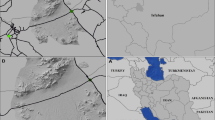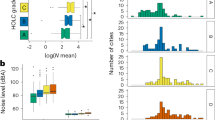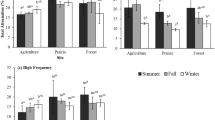Abstract
The extensive literature documenting the ecological effects of roads has repeatedly implicated noise as one of the causal factors. Recent studies of wildlife responses to noise have decisively identified changes in animal behaviors and spatial distributions that are caused by noise. Collectively, this research suggests that spatial extent and intensity of potential noise impacts to wildlife can be studied by mapping noise sources and modeling the propagation of noise across landscapes. Here we present models of energy extraction, aircraft overflight and roadway noise as examples of spatially extensive sources and to present tools available for landscape scale investigations. We focus these efforts in US National Parks (Mesa Verde, Grand Teton and Glacier) to highlight that ecological noise pollution is not a threat restricted to developed areas and that many protected natural areas experience significant noise loads. As a heuristic tool for understanding past and future noise pollution we forecast community noise utilizing a spatially-explicit land-use change model that depicts the intensity of human development at sub-county resolution. For road noise, we transform effect distances from two studies into sound levels to begin a discussion of noise thresholds for wildlife. The spatial scale of noise exposure is far larger than any protected area, and no site in the continental US is free form noise. The design of observational and experimental studies of noise effects should be informed by knowledge of regional noise exposure patterns.






Similar content being viewed by others
Explore related subjects
Discover the latest articles and news from researchers in related subjects, suggested using machine learning.References
Barber JR, Crooks C, Fristrup K (2010) The costs of chronic noise exposure for terrestrial organisms. Trends Ecol Evol 25:180–189
Bayne EM, Habib L, Boutin S (2008) Impacts of chronic anthropogenic noise from energy-sector activity on abundance of songbirds in the boreal forest. Conserv Biol 22:1186–1193
Benítez-López A, Alkemade R, Verweij PA (2010) The impacts of roads and other infrastructure on mammal and bird populations: a meta-analysis. Biol Conserv 143:1307–1316
Bermúdez-Cuamatzin E, Ríos-Chelén AA, Gil D, Garcia CM (2011) Experimental evidence for real-time song frequency shift in response to urban noise in a passerine bird. Biol Lett 23:36–38
Bierwagen B, Theobald DM, Pyke CR, Choate A, Groth AP, Thomas JV, Morefield P (2010) National housing and impervious surface scenarios for integrated climate impact assessments. Proc Natl Acad Sci USA 107(49):20887–20892
Blickley JL, Patricelli GL (2011) Impacts of anthropogenic noise on wildlife: research priorities for the development of standards and mitigation. J Int Wildl Law Policy (in press)
Blickley JL, Blackwood D, Paticelli GL (2011) Experimental evidence for avoidance of chronic noise exposure by greater sage-grouse. Conserv Biol (in review)
Chan AAY-H, Giraldo-Perez P, Smith S, Blumstein DT (2010) Anthropogenic noise affects risk assessment and attention: the distracted prey hypothesis. Biol Lett 6:458–461
Clark CW, Ellison WT, Southall BL, Hatch L, Van Parijs SM, Frankel A, Ponirakis D (2009) Acoustic masking in marine ecosystems: intuitions, analysis, and implication. Mar Ecol Prog Ser 395:201–222
Dumyahn SL, Pijanowski BC (2011) Beyond noise mitigation: managing soundscapes as common-pool resources. Landscape Ecol (published online 4 August 2011)
Dunn RR, Gavin MC, Sanchez MC, Solomon JN (2006) The pigeon paradox: dependence of global conservation on urban nature. Conserv Biol 6:1814–1816
Efroymson RA, Sutter GW (2001) Ecological risk assessment framework for low-altitude aircraft overflights: estimating effects on wildlife. Risk Anal 21:263–274
Eigenbrod F, Hecnar SJ, Fahrig L (2009) Quantifying the road-effect zone: threshold effects of a motorway on anuran populations in Ontario, Canada. Ecol Soc 14(1):24
Environmental Protection Agency (EPA), USA (1974a) Population distribution of the United States as a function of outdoor noise level. Report 550/9-74-009
Environmental Protection Agency (EPA), USA (1974b) Information on levels of environmental noise requisite to protect public health and welfare with an adequate margin of safety. Report 550/9-74-004
ESRI (2009) ArcGIS 9.3.1. ESRI (Environmental Systems Research Institute), Redlands
Fahrig L, Rytwinski T (2009) Effects of roads on animal abundance: an empirical review and synthesis. Ecol Soc 14:21. http://www.ecologyandsociety.org/vol14/iss1/art21/
Fang C, Ling D (2003) Investigation of the noise reduction provided by tree belts. Landsc Urban Plan 63:187–195
Federal Interagency Committee on Noise, USA (1992) Federal agency review of selected airport noise analysis issues
Forman RTT (2000) Estimate of the area affected ecologically by the road system in the United States. Conserv Biol 14:31–35
Forman RTT, Reineking B, Hersperger AM (2002) Road traffic and nearby grassland bird patterns in a suburbanizing landscape. Environ Manage 29:782–800
Francis CD, Ortega CP, Cruz A (2009) Noise pollution changes avian communities and species interactions. Curr Biol 19:1415–1419
Francis CD, Paritsis J, Ortega CP, Cruz A (2011) Landscape patterns of avian habitat use and nest success are affected by chronic gas well compressor noise. Landscape Ecol (published online 3 May 2011)
Goodwin SE, Shriver G (2011) Effects of traffic noise on occupancy patterns of forest birds. Conserv Biol 25:406–411
Gross K, Pasinelli G, Kunc HP (2010) Behavioral plasticity allows short-term adjustment to a novel environment. Am Nat 176:456–464
Habib L, Bayne EM, Boutin S (2007) Chronic industrial noise affects pairing success and age structure of ovenbirds Seiurus aurocapilla. J Appl Ecol 44:176–184
Halfwerk W, Holleman LJM, Lesselis CM, Slabbekoorn H (2011) Negative impact of traffic noise on avian reproductive success. J Appl Ecol 48:210–219
Kaliski K, Duncan E (2008, December) Propagation modeling parameters for wind power projects. Sound Vib, pp 12–15
Kaliski K, Duncan E, Cowan J (2007, September) Community and regional noise mapping in the United States. Sound Vib, pp 14–17
Kerth G, Melber M (2009) Species-specific barrier effects of a motorway on the habitat use of two threatened forest-living bat species. Biol Conserv 142:270–279
Kidd G, Mason CR, Richards VM, Gallun FJ, Durlach NI (2008) Informational masking. In: Yost WA, Popper AN, Fay RR (eds) Auditory perception of sound sources. Springer, New York, pp 143–190
Leu M, Hanser SE, Knick ST (2008) The human footprint in the west: a large-scale analysis of anthropogenic impacts. Ecol Appl 18:1119–1139
Lynch E, Joyce D, Fristrup K (2011) An assessment of noise audibility and sound levels in U.S. National Parks. Landscape Ecol. doi:10.1007/s10980-011-9643-x
Mcdonald RI, Forman RTT, Kareiva P, Neugarten R, Salzer D, Fisher J (2009) Urban effects, distance, and protected areas in an urbanizing world. Landsc Urban Plan 93:63–75
Mennitt DJ, Fristrup K (2011) Methods and accuracy of obtaining calibrated sound pressure levels from consumer digital audio recorders. Appl Acoust (in review)
Nemeth E, Brumm H (2010) Birds and anthropogenic noise: are urban songs adaptive? Am Nat 176:467–475
Nowacek DP, Thorne LH, Johnston DW, Tyack PL (2007) Responses of cetaceans to anthropogenic noise. Mamm Rev 37:81–115
O’Neill RV, DeAngelis DL, Waide JB, Allen TFH (1986) A hierarchical concept of ecosystems. Princeton University Press, Princeton
Ortega CP, Francis CD (2011) Effects of gas well compressor noise on ability to detect birds during surveys in the rattlesnake canyon habitat management area, San Juan County, New Mexico. Ornithol Monographs (in press)
Pater LL, Grubb TG, Delaney DK (2009) Recommendations for improved assessment of noise impacts of wildlife. J Wildl Manag 73:788–795
Patricelli GL, Blickley JL (2006) Avian communication in urban noise: causes and consequences of vocal adjustment. Auk 123:639–649
Payne R, Webb D (1971) Orientation by means of long range acoustic signaling in baleen whales. Ann NY Acad Sci 188:110–141
Pijanowski BC, Farina A, Gage SH, Dumyahn SL, Krause BL (2011) What is soundscape ecology? An introduction and overview of an emerging new science. Landscape Ecol (published online 1 May 2011)
Reed SE, Boggs JL, Mann JP (2011) SPreAD-GIS: a tool for modeling anthropogenic noise propagation in natural ecosystems. Ecography (in review)
Reijnen R, Foppen R (1995) The effects of car traffic on breeding bird populations in woodland. III. Reduction of density in relation to the proximity of main roads. J Appl Ecol 32:187–202
Reijnen R, Foppen R (2006) Impact of road traffic on breeding bird populations. In: Davenport J, Davenport JL (eds) The ecology of transportation: managing mobility for the environment. Springer, Dordrecht, pp 255–274
Reijnen R, Foppen R, Meeuwsen H (1996) The effects of traffic on the density of breeding birds in Dutch agricultural grasslands. Biol Conserv 75:255–260
Reijnen R, Foppen R, Veenbaas G (1997) Disturbance by traffic as a threat to breeding birds: evaluation of the effect and considerations in planning and managing road corridors. Biodivers Conserv 6:567–581
Reindt FE (2003) The impact of roads on birds: does song frequency play a role in determining susceptibility to noise pollution? J Ornithol 144:295–306
Riitters KH, Wickham JD (2003) How far to the nearest road? Front Ecol Environ 1:125–129
Ripmeester EAP, Mulder M, Slabbekoorn H (2010) Habitat-dependent acoustic divergence affects playback response in urban and forest populations of the European blackbird. Behav Ecol 21:876–883
Roedenbeck IA, Fahrig L, Findlay CS, Houlahan JE, Jaeger JAG, Klar N, Kramer-Schadt S, van der Grift EA (2007) The Rauischholzhausen agenda for road ecology. Ecol Soc 12:11. http://www.ecologyandsociety.org/vol12/iss1/art11/
Rossing TD (ed) (2007) Springer handbook of acoustics. Springer, New York
Schaub A, Ostwald J, Siemers BM (2008) Foraging bats avoid noise. J Exp Biol 211:3174–3180
Shafer CL (1999) US national park buffer zones: historical, scientific, social and legal aspects. Environ Manage 23:49–73
Siemers BM, Schaub A (2010) Hunting at the highway: traffic noise reduces foraging efficiency in acoustic predators. Proc R Soc B (published online 17 Nov 2010)
Slabbekoorn H, Peet M (2003) Birds sing at a higher pitch in urban noise. Nature 424:267
Slabbekoorn H, Ripmeester EAP (2008) Birdsong and anthropogenic noise: implications and applications for conservation. Mol Ecol 17:72–83
St. Clair CC (2003) Comparative permeability of roads, rivers, and meadows to songbirds in Banff National Park. Conserv Biol 17:1151–1160
Stewart CM, Russel WA, Luz GA (1999) Can population density be used to determine ambient noise levels? (Abstract). J Acoust Soc Am 105:942
Summers PD, Cunnington GM, Fahrig L (2011) Are the negative effects of roads on breeding birds caused by traffic noise. J Appl Ecol (published online 19 July 2011)
Theobald DM (2005) Landscape patterns of exurban growth in the USA from 1980 to 2020. Ecol Soc 10:1. http://www.ecologyandsociety.org/vol10/iss1/art32
Wade AA, Theobald DM (2009) Residential development encroachment on US protected areas. Conserv Biol 24:151–161
Warren PS, Katti M, Ermann M, Brazel A (2006) Urban bioacoustics: it’s not just noise. Anim Behav 71:491–502
Weilgart LS (2007) The impacts of anthropogenic ocean noise on cetaceans and implications for management. Can J Zool 85:1091–1116
World Health Organization (1999) Guidelines for community noise. WHO, Geneva
Acknowledgments
We thank Brian Pijanowski for the invitation to contribute to this special issue, two anonymous reviewers for their insight and our colleagues in the Natural Sounds and Night Skies Division of the National Park Service for discussion and continued efforts to protect sensory resources.
Author information
Authors and Affiliations
Corresponding author
Electronic supplementary material
Below is the link to the electronic supplementary material.
Supplementary material 1 (WMV 6903 kb)
Supplementary material 2 (WMV 8622 kb)
Rights and permissions
About this article
Cite this article
Barber, J.R., Burdett, C.L., Reed, S.E. et al. Anthropogenic noise exposure in protected natural areas: estimating the scale of ecological consequences. Landscape Ecol 26, 1281–1295 (2011). https://doi.org/10.1007/s10980-011-9646-7
Received:
Accepted:
Published:
Issue Date:
DOI: https://doi.org/10.1007/s10980-011-9646-7




